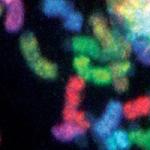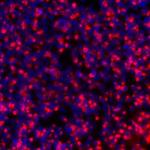
Research Topics
We investigate epigenomic regulation of gene expression and cell differentiation, with a focus on enhancer regulation by histone modifying or chromatin remodeling enzymes. We also study epigenomic regulation of adipose tissue development and expansion.
Current Research
Epigenomic regulation of enhancers
Enhancers control cell-type-specific gene expression and are critical for cell differentiation and animal development. Primed enhancers are marked by histone H3K4 mono-methylation (H3K4me1). Active enhancers are further marked by H3K27 acetylation (H3K27ac). We identified MLL3 (KMT2C) and MLL4 (KMT2D) as major H3K4me1 methyltransferases on enhancers (eLife 2013), and CBP and p300 as the H3K27 acetyltransferases in mammalian cells (EMBO J 2010).
PPARγ is a lineage-determining transcription factor (LDTF) essential for adipogenesis. In search for novel PPARγ cofactors, we identified a nuclear protein complex that contains MLL3/4 and the H3K27 demethylase UTX (KDM6A) (JBC 2007, PNAS 2007). MLL3/4 and UTX are tumor suppressors highly mutated in many types of cancers as well as Kabuki syndrome and congenital heart disease (Development 2016, Development 2020, Nat Cell Biol 2023, reviewed in Gene 2017, MCB 2020a). We have shown:
- MLL3/4 colocalize with LDTFs on active enhancers and are generally required for enhancer activation, cell-type-specific gene expression, cell differentiation and tissue development (eLife 2013, NAR 2019). MLL3/4 control cell fate transition by orchestrating H3K27 acetyltransferases CBP/p300-mediated enhancer activation (NAR 2017).
- MLL3/4 proteins, rather than H3K4me1, controls p300 recruitment to enhancers during ES cell differentiation (PNAS 2016). Consistently, MLL3/4 enzymatic activities and H3K4me1 are largely dispensable for enhancer activation during ES cell differentiation. By inactivating MLL3/4 enzymatic activities in mice and ES cells, we show that MLL3/4 methyltransferase activities are redundant and are essential for early embryonic development. MLL3/4 enzymatic activities control early embryonic development and ES cell differentiation in a lineage-selective manner (Nat Genet 2023).
- The epigenomic reader Brd4 binds to active enhancers to control cell identity gene induction in adipogenesis and myogenesis. Our data suggest a model of sequential actions of epigenomic regulators on enhancers: 1) LDTFs recruit MLL3/4 to prime enhancers, 2) MLL3/4 facilitate the binding of CBP/p300, which activate enhancers, 3) Brd4 recognizes active enhancers and recruits Mediator and RNA Polymerase II to activate cell-type-specific gene expression (Nat Commun 2017).
- A positive feedback between MLL4 and the SWI/SNF chromatin remodeling complex BAF in promoting LDTF-dependent activation of cell type-specific enhancers (Nat Commun 2021).
- UTX protein, but not its H3K27 demethylase activity, is required for ES cell differentiation and mouse development (PNAS 2012). Interestingly, UTX demethylase activity is required for stem cell-mediated muscle regeneration (JCI 2016).
- While the MED1 subunit of the Mediator coactivator complex marks active enhancers, it plays a cell- and gene-specific regulatory role and is not generally required for transcription (Genes Dev 2021).
Epigenomic regulation of adipose tissue development and expansion
Epigenomic mechanisms play critical roles in adipose tissue development (adipogenesis, reviewed in MCB 2019) and expansion. We have shown:
- H3K4 methyltransferases MLL3/4 and associated PTIP directly control the induction of principal adipogenic TFs PPARγ and C/EBPα and are essential for adipogenesis (Cell Metab 2009, eLife 2013). MLL3/4-associated PAGR1 regulates adipogenesis by controlling induction of C/EBPβ and C/EBPδ (MCB 2020b).
- H3K9 methyltransferase G9a represses PPARγ expression and adipogenesis (EMBO J 2013) while H3K27 methyltransferase Ezh2 represses Wnt genes to facilitate adipogenesis (PNAS 2010). Depletion of Nsd2-mediated H3K36 methylation impairs adipose tissue development and function (Nat Commun 2018).
- Brd4 binding on active enhancers controls cell identity gene induction in adipogenesis (Nat Commun 2017).
- BAF is the major SWI/SNF complex that colocalizes with MLL4 and LDTFs on active enhancers. BAF is required for adipogenesis while the promoter enriched SWI/SNF complex PBAF is dispensable (Nat Commun 2021).
- The active enhancer marker MED1 is a lipogenesis coactivator required for postnatal adipose expansion (Genes Dev 2021).
- Although ligand-bound glucocorticoid receptor (GR) accelerates adipogenesis in culture, endogenous GR is dispensable for adipogenesis in culture and in mice (MCB 2017a). KLF4 and Krox20 are dispensable for adipogenesis (MCB 2017b).
Biography
- Postdoctoral Fellow, The Rockefeller University, 2000–2003
- Postdoctoral Fellow, The Wistar Institute, 1997–2000
- Ph.D., Shanghai Institute of Biochemistry, Chinese Academy of Sciences, 1997
- B.S., Fudan University, 1992
Selected Publications
- Van HT, Xie G, Dong P, Liu Z, Ge K. KMT2 Family of H3K4 Methyltransferases: Enzymatic Activity-dependent and -independent Functions. J Mol Biol. 2024;436(7):168453.
- Zhang Y, Xie G, Lee JE, Zandian M, Sudarshan D, Estavoyer B, Benz C, Viita T, Asgaritarghi G, Lachance C, Messmer C, Simonetti L, Sinha VK, Lambert JP, Chen YW, Wang SP, Ivarsson Y, Affar EB, Côté J, Ge K, Kutateladze TG. ASXLs binding to the PHD2/3 fingers of MLL4 provides a mechanism for the recruitment of BAP1 to active enhancers. Nat Commun. 2024;15(1):4883.
- Xie G, Lee JE, Senft AD, Park YK, Jang Y, Chakraborty S, Thompson JJ, McKernan K, Liu C, Macfarlan TS, Rocha PP, Peng W, Ge K. MLL3/MLL4 methyltransferase activities control early embryonic development and embryonic stem cell differentiation in a lineage-selective manner. Nat Genet. 2023;55(4):693-705.
- Jang Y, Park YK, Lee JE, Wan D, Tran N, Gavrilova O, Ge K. MED1 is a lipogenesis coactivator required for postnatal adipose expansion. Genes Dev. 2021;35(9-10):713-728.
- Park YK, Lee JE, Yan Z, McKernan K, O'Haren T, Wang W, Peng W, Ge K. Interplay of BAF and MLL4 promotes cell type-specific enhancer activation. Nat Commun. 2021;12(1):1630.
Related Scientific Focus Areas





Molecular Biology and Biochemistry
View additional Principal Investigators in Molecular Biology and Biochemistry
This page was last updated on Thursday, August 7, 2025